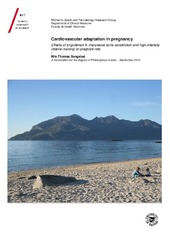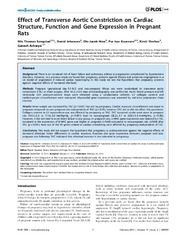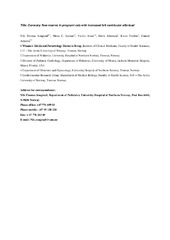| dc.contributor.advisor | Acharya, Ganesh | |
| dc.contributor.author | Songstad, Nils Thomas | |
| dc.date.accessioned | 2014-10-27T14:46:34Z | |
| dc.date.available | 2014-10-27T14:46:34Z | |
| dc.date.issued | 2014-09-18 | |
| dc.description.abstract | Objectives: To investigate how cardiac function, remodeling and gene expression are affected in pregnancy in response to cardiovascular stress, to detect possible adverse effects on the fetus, and to evaluate if coronary endothelial function is influenced by pregnancy and increased cardiac afterload.
Methods: Pregnant and non-pregnant rats were subjected to chronic AngII-infusion, transverse aortic constriction (TAC) or high-intensity interval training (HIIT) in three separate studies. Echocardiography was used to evaluate maternal heart function. Doppler signals from the left coronary artery was used to asses coronary flow reserve (CFR) using 3.5% inhaled isoflurane as a vasodilating agent. Blood pressure and left ventricle (LV) pressure and volume were measured invasively using a conductance catheter placed in the LV. Histological sections of the maternal LV were used to determine collagen content, vessel density and myocyte size. RT-PCR was used to quantify the gene expression in maternal myocardium and fetuses. Level of oxidative stress was measured in fetal tissue in the HIIT-study.
Results: Chronic AngII infusion resulted in increased myocardial collagen content, and pregnancy reduced this effect. A decrease in LV vessel density following AngII infusion was less severe in pregnant rats. Calculated stroke work in pregnant TAC rats was double compared to pregnant shams, whereas it was not significantly increased in non-pregnant TAC rats compared to non-pregnant shams. The ratio of β-MHC to α-MHC expression was higher in pregnant compared to non-pregnant TAC. HIIT did not alter maternal cardiac structure or function, fetal growth or level of oxidative stress in the placenta or fetuses. There were no differences in CFR between rats with increased afterload (AngII or TAC) and controls. CFR was lower in pregnant compared to non-pregnant rats.
Main conclusions: Pregnancy was protective against fibrosis and preserved angiogenesis in AngII infused rats. Increased afterload following TAC was less tolerated in pregnancy. CFR is reduced in late pregnancy. HIIT is feasible and well tolerated by pregnant rats and did not induce significant changes in the fetus. | en |
| dc.description.doctoraltype | ph.d. | en |
| dc.description.popularabstract | Hjertet til gravide og ikke-gravide rotter ble belastet på tre forskjellige måter. Vi etterlignet effekten av høyt blodtrykk ved svangerskapsforgiftning ved å tilføre angiotensin II, et hormon som fører til blodstrykksøkning. Hovedpulsåren ble innsnevret kirurgisk, for å simulerer effekten av noen medfødte hjertefeil. Og rotter ble utsatt for intervalltrening bestående av løping på melkesyreterskelen i 10x4 minutter 5 dager i uka. Vi fant at graviditet virket beskyttende mot noen av de skadelige effektene angiotensin II kan ha på hjertet, men ikke mot belastning som skyldes innsnevring av hovedpulsåren. Gravide rotter tålte høyintensitets intervalltrening like godt som ikke-gravide rotter, rottefostrene vokste normalt, og vi fant ikke sikre tegn til surstoffmangel i morkake og foster. Denne avhandlingen bidrar med ny kunnskap om hvordan hjertes svar på stress blir påvirket av graviditet. | en |
| dc.description.sponsorship | Arbeidet beskrevet i avhandlingen ble finansiert av forskningmidler fra Helse Nord og av Universitetet i Tromsø. Kandidaten ble finnansiert gjennom PhD-stipend fra Helse Nord | en |
| dc.description | Paper a and c of the thesis are not available in Munin: <p>a: 'Pregnancy protects against antiangiogenic and fibrogenic effects of angiotensin II in rat hearts', available in <a href=http://dx.doi.org/10.1111/j.1748-1716.2010.02234.x>Acta Physiologica 2011, 201, 445–456</a></p>
<p>c: 'High intensity interval training in pregnant rats alters gene expression in fetal heart and liver without inducing oxidative stress' (manuscript). Later published with altered title in <a href=http://dx.doi.org/10.1371/journal.pone.0143095>PLoS ONE 10(11): e0143095.</a></p> | en |
| dc.identifier.uri | https://hdl.handle.net/10037/6770 | |
| dc.identifier.urn | URN:NBN:no-uit_munin_6366 | |
| dc.language.iso | eng | en |
| dc.publisher | UiT The Arctic University of Norway | en |
| dc.publisher | UiT Norges arktiske universitet | en |
| dc.rights.accessRights | openAccess | |
| dc.rights.holder | Copyright 2014 The Author(s) | |
| dc.rights.uri | https://creativecommons.org/licenses/by-nc-sa/3.0 | en_US |
| dc.rights | Attribution-NonCommercial-ShareAlike 3.0 Unported (CC BY-NC-SA 3.0) | en_US |
| dc.subject | VDP::Medisinske Fag: 700::Klinisk medisinske fag: 750::Gynekologi og obstetrikk: 756 | en |
| dc.subject | VDP::Medical disciplines: 700::Clinical medical disciplines: 750::Gynecology and obstetrics: 756 | en |
| dc.subject | VDP::Medisinske Fag: 700::Klinisk medisinske fag: 750::Pediatri: 760 | en |
| dc.subject | VDP::Medical disciplines: 700::Clinical medical disciplines: 750::Pediatrics: 760 | en |
| dc.subject | VDP::Medisinske Fag: 700::Basale medisinske, odontologiske og veterinærmedisinske fag: 710::Human og veterinærmedisinsk fysiologi: 718 | en |
| dc.subject | VDP::Medical disciplines: 700::Basic medical, dental and veterinary science disciplines: 710::Human and veterinary science physiology: 718 | en |
| dc.subject | VDP::Medisinske Fag: 700::Basale medisinske, odontologiske og veterinærmedisinske fag: 710::Patofysiologi: 721 | en |
| dc.subject | VDP::Medical disciplines: 700::Basic medical, dental and veterinary science disciplines: 710::Physiopathology: 721 | en |
| dc.subject | VDP::Medisinske Fag: 700::Klinisk medisinske fag: 750::Kardiologi: 771 | en |
| dc.subject | VDP::Medical disciplines: 700::Clinical medical disciplines: 750::Cardiology: 771 | en |
| dc.title | Cardiovascular adaptation in pregnancy -
Effects of angiotensin II, transverse aorta constriction and high-intensity interval training on pregnant rats | en |
| dc.type | Doctoral thesis | en |
| dc.type | Doktorgradsavhandling | en |


 English
English norsk
norsk





